Crick
Gold Member
- May 10, 2014
- 29,338
- 5,703
I have to give you credit for realizing that you'll never reject AGW without rejecting the greenhouse effect. But if it ever troubled you to pit yourself against 97% of the world's active climate scientists, the idea of rejecting a physical process that is probably accepted by more than 99% of ALL scientists has to give you some reason to pause.
But apparently not.
But apparently not.

